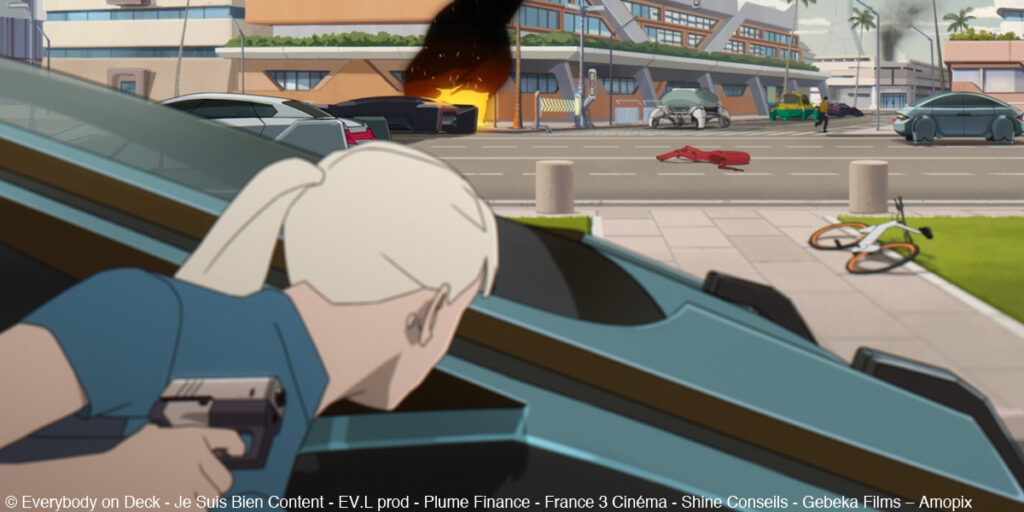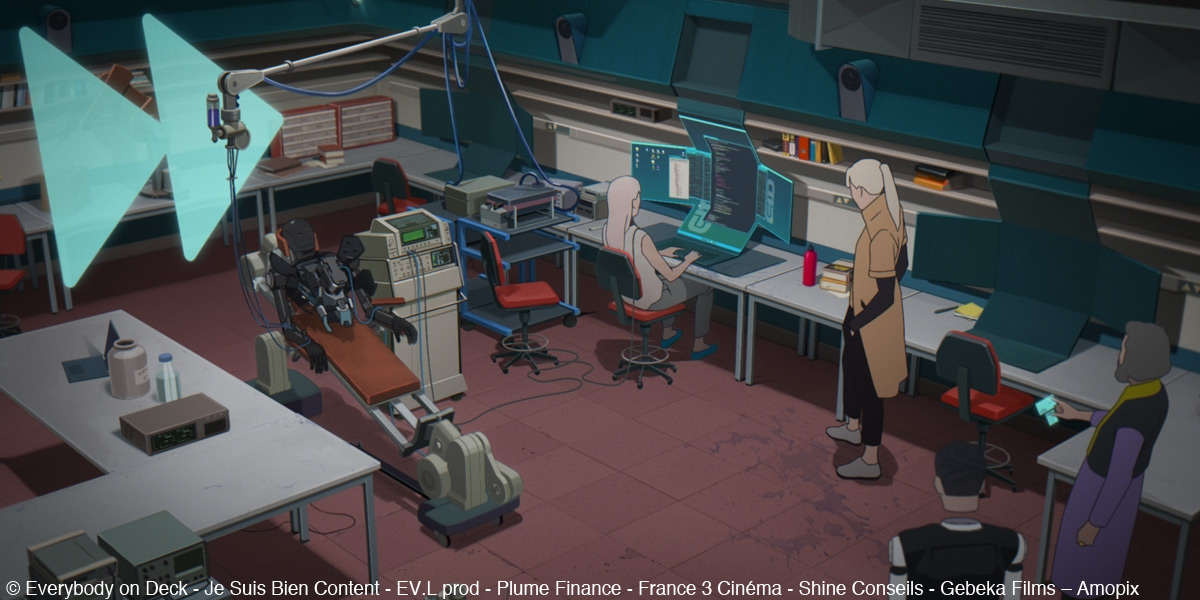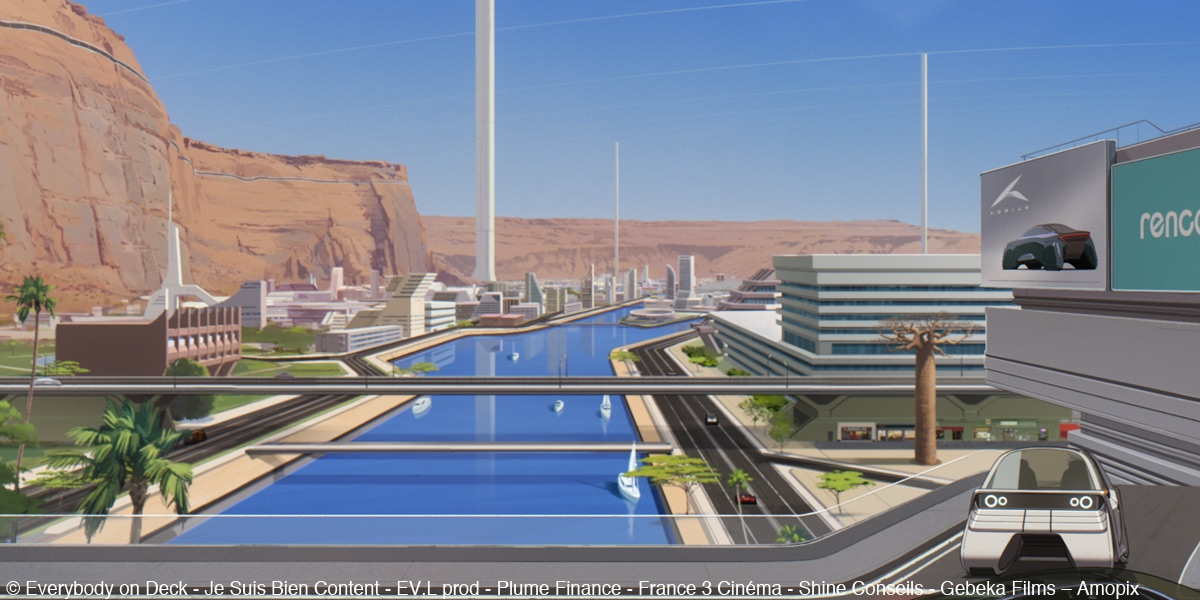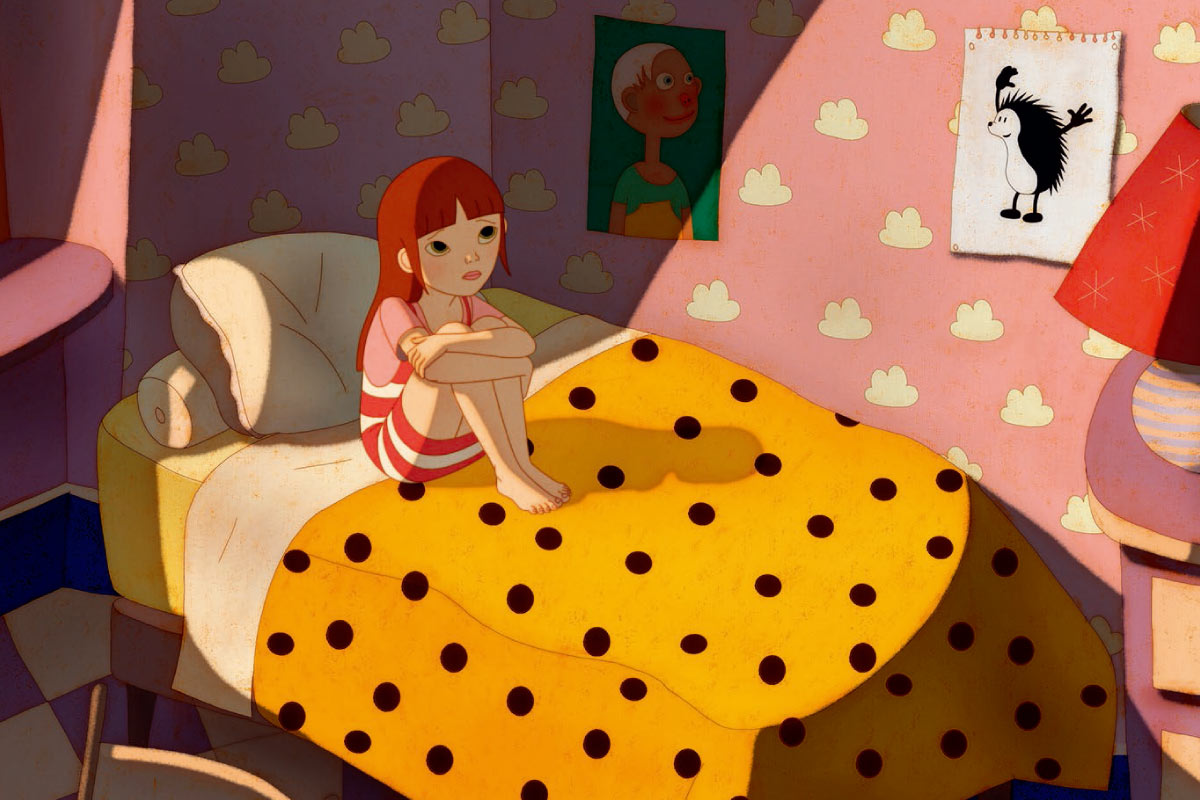Synopsis
In 2200, private detective Aline Ruby and her android partner Carlos Rivera are hired by a wealthy businessman to track down a notorious hacker. On Mars, they descend deep into the underbelly of the planet’s capital city where they uncover a darker story of brain farms, corruption, and a missing girl who holds a secret about the robots that threatens to change the face of the universe.
Film credits
Director: Jérémie Périn
Authors: Laurent Sarfati and Jérémie Périn
Producers: Didier Creste (Everybody on Deck, France), Marc Jousset (Je Suis Bien Content, France)
Music: Fred Avril and Philippe Monthaye
Sound: Fanny Bricoteau and Matthieu Dallaporta
Editing: Lila Desiles
Target audience: Young Adults / Adults
Technique: 2D digital
Running time: 1h 25 min
Mars Express is a compelling Sci-Fi film filled with intriguing elements that explores the relationship between humans and robots. The film had its world premiere at the Cannes Film Festival 2023, then later screened at the Annecy International Animation Film Festival 2023 as one of the nominees for Feature Films in Competition Official.
With the film’s meticulously crafted narrative and stunning visuals, this 90-minute adventure will leave even discerning Sci-Fi viewers satisfied. Additionally, it raises thought-provoking questions about the future of humanity and AI, delving into themes such as inequality and alienation, and the film’s perspective on Isaac Asimov’s “Three Laws of Robotics”.
We interviewed Jérémie Périn and Laurent Sarfati, who previously discussed the film all the way back in Cartoon Movie 2019. In our recent interview, we heard the story behind the creation of Mars Express after the project’s completion.
Interview with Jérémie Périn and Laurent Sarfati
Hideki Nagaishi (HN): What parts of Mars Express do you think is appealing or attractive to the audience?
Jérémie Périn: From what I read on Twitter (now “X”), the first scene of Mars Express grabbed the people who watched the film at the Annecy festival. There’s some action going on the scene and they already loved it, thinking “Oh, this is really a Sci-Fi film!” And that was my goal.
Laurent Sarfati: I also checked Twitter, and one of the scenes a lot of people remembered and liked a lot is the car chase. All the elements of the car chase are in that sequence. But, it’s also an opposite to a car chase, as we twisted the general ideas of a car chase. Everything is stopped and nothing happens with the car itself, but everything else moves around it. I think it’s very rare that something new happens in a car chase scene in films.
HN: The next question is about the film’s story. You put a lot of ideas into the story, but the main story of the film isn’t complicated and it is straightforward to follow. What did you take care in the most and what were the big challenges for you during your journey in developing the film’s story? I especially want to hear about the story structure, the mystery elements and the detective elements.
Jérémie Périn: One of the most challenging parts was to make the story’s world and all the technology inside the film understandable for everyone. And what we did was to just show it without explaining how it works. So, our idea was to show it generally in different parts of the film and give you some pieces to notice and understand them naturally. For example, Aline and Carlos talk to each other telepathically for the first time, and then you see later the interface in Aline’s eye and you understand that there are some menus and stuff. It was explained visually with as little dialogue as possible. This was one of the biggest difficulties.
Laurent Sarfati: In addition to that, the main difficulty for me as a scriptwriter was writing the script because there are so many visual elements that we don’t want to explain in the script, like what the characters do as their everyday routine, because it’s supposed to be natural for them. It’s very hard to describe them without a script, but it’s more fluent on screen than by reading it.
Jérémie Périn: We try not to make it boring with too much description, as to make it natural when you see the action. But, in the script, you have to explain it like “they put some mutant in here, and here’s a new phone from the future…” and so on.
Laurent Sarfati: Yes, that was tough. And the stories have many layers and there are dots in the storyline. And it was a challenge not to make the storylines too big or too small. If they’re too small, they completely disappear. If they are too big, they cannot be in the main story. For example, humanity trying to migrate on the exoplanet. I will spoil nothing, but it’s a storyline along the movie and it spans from the very start to the very end. And we had developed it the right amount. That was tough.
HN: So, unlike many fantasy or Sci-Fi films, you intentionally didn’t explain every bit of information from the universe the story takes place in.
Laurent Sarfati: Yes, because we hate it. As an audience, when a film explains a lot to us, we feel damned.
Jérémie Périn: Also, what we feel from these kind of films is that the characters know the audience is watching them, so they explain for us. I think it’s weird. I prefer to be like a witness of a world existing outside of me. So, we want to make a film with expressiveness to put the audience inside the film, and they could just look at it and sometimes be thinking about what they are seeing right now. It resolves the mystery of the plot, of course, but also shows the world they are watching.
Laurent Sarfati: To sum up all of these, the hardest part was to find the sweet, sweet spots between being complicated – so you don’t understand the story – and explaining things to the audience. There is a middle. It is the right spot and it’s very thin.
HN: I felt that the film has right number of action scenes at the right places in the story and it provides us fun and excitement moments. I’m curious about how you managed and achieve that kind of story structure.
Jérémie Périn: Generally, a classic structure for a script is in the three acts: the beginning, the middle of the film, and the end, the climax. So, we tried to put actions at those moments. And there were also some moments in the film where it could be nice to have something more dynamic because we have a large audience and maybe some of them will be bored during those moments! So, let’s put them in those kind of situations and they will stay awake. It’s more or less a technical idea related to the structure of and the work of the script, but also something closer to the feeling we have.
Laurent Sarfati: Writing is a technique more than an art, especially with scriptwriting which is all about the structure.
HN: After you finished writing the whole script and you start to draw the storyboard, did you find out or have something appear later on, like “this scene should be later on this arc”, or “this need to be before this”, and suggest to each other how to change the story structure? Did these kinds of things happen?
Jérémie Périn: Not so much, in fact. We are in a country where the funding for an animation film are not as big as in the US. So, we need to use poor people techniques (laugh).
Laurent Sarfati: In writing it’s also called ‘smart techniques’!
Jérémie Périn: It means that the phase of the film production starting with the script has to be strongly worked on. We work a lot on it, and reworking the script is less expensive than making changes on the storyboard. We have to work until everything is locked in for the script. Sometimes we change the storyboard, but maybe will be taking off a sequence or putting new information on there, but it’s always very small details. Like changing some dialogue, but the scene remains the same, it’s just different words in the mouth of the characters.
Laurent Sarfati: Sometimes a little bit too much information and sometimes a little bit too little information, but that’s the main point of every writer who writes with the director, who has to be a writer too, especially in animation. Because it’s like an IKEA furniture’s instructions. If a piece of information is missing when you’re assembling it, it’s a disaster. The plan, the blueprint, has to be as perfect as possible.
HN: The next question is all about the visuals. The film has magnificent scenes, attractive design of machines, and many new technologies, and great visuals of the film’s universe on Mars. Could you please let us know about the most challenging parts or the highlights of creating Mars Express?
Jérémie Périn: That’s the work of Mikael Robert, the art director. The most difficulty on the visual design we had was to feel that everything is coherent. At the same time, we hired two different creators to design all the robots, but like how Apple and Google have different designers, it’s not the same industry though. And we had the luck to work with the real car designer for the main car, Aline and Carlos’ car. His name is Félix Godardwho worked with Porsche and Tesla.
We had to work all those designs, thinking about how all the technology works, and stick to some general ideas we could spread on everything. Then, even if we don’t explain how they work, the audience feels that they work with the same kind of logic. And sometimes we were very embarrassed because we in fact had to think every furniture, every glass, everything. It’s 200 years into the future and, of course, we still need some tables and stuff. We didn’t want to have like a laser pen or some transparent phones in the film. We hate them because it’s stupid to have a transparent screen for computers as you can see in some Sci-Fi films. I feel it’s not really useful. We wanted all the technology in the film to be useful in fact, and feel like we could take it right now and understand how it works and use it.
Laurent Sarfati: It was very fun when I was going to the studio to visit them. They were always trying to imagine how to use and the function of every object they were designing. It was like a game.
HN: The next question is about the music. Could you please let us know the story behind composing the music?
Jérémie Périn: The music is by Fred Avril and Philippe Monthaye. We had worked together already on season one of Lastman (2016), and my idea was to find a specific way for the music in the Sci-Fi film, because I had two possibilities of the music: classical music like 2001: A Space Odyssey (1968) or synthesizer music like in Blade Runner (1982). So, my first idea was to ask Fred and Philippe to merge both by creating music with real and digital instruments all together. In that way, the audience doesn’t hear the difference between the two music styles and can’t identify what kind of instrument it is. In the end, they didn’t really do that (laugh). But they searched for a not-so-used weird instrument, like the Cristal Baschet which has a glass keyboard and you play with wet fingers. You use water to play. It’s really strange! So, they used different kinds of instruments regardless: real drums, classical instrument like cello, contemporary instruments like synthesizer, and weird ones.
After that, we watched the film several times all together to discuss about where the music should happen and where the music shouldn’t be there; a classic way of working with musicians on films.
I gave them freedom by providing no placeholder music. The typical way is putting music you like when you edit the animatic of the film, so that some music is there. But the composers don’t like that because the director becomes used to that placeholder music and wants the musician to copy that previous music in the end. With our way, I think Fred and Philippe felt more freedom to work to compose make their own thing with no reference, without being annoyed by listening to other people’s music. And I could use their own music.
Note: There will be spoilers below:
HN: The next question is about a big creature in the climax of the film. I thought only human and robot characters appeared in the film, until the climax scene. Why did you decide to prepare a creature with blood for that scene? I want to know your intentions.
Jérémie Périn: I need to spoil a bit to answer the question, but the big creature is called Raphael. It is an organic mutant of the same family of the technology of the weird mutant phone you can see in the film. That technology aims to compete with robots that dominate the market on Mars.
HN: I think the theme of the film, that underlines the whole story throughout, is the two opposite groups: humans and robots. What is the main reason why you put the organic creatures as the third group in the film?
Laurent Sarfati: Everyone has a robot and it’s very effective. So, people are trying to sell something new as assistance for humans. It’s mostly a marketing argument.
Jérémie Périn: Our main idea was to make the human figure not so much the centre of the story. In classical Sci-Fis, usually humans are the centre of the plot. Like stories where the aliens or robots are fascinated by humans. People have been writing stories about how cool humans are, and how fascinating we are. But with Mars Express, that’s not the case.
Laurent Sarfati: So, we tried to write the film as if we weren’t human, like we were octopuses who are writing a story about humans and robots (laugh).
HN: When I saw the creature, I am reminded of the big machine at the final battle scene in Ghost in the Shell (1995).
Jérémie Périn: I tried different stuff. In the first place, I tried some weird design instead of the actual design and it has a Evangelion look to it. So, I have to choose between Evangelion and Ghost in the Shell… anyway, my choice came for the one that has the more pragmatic design, the more useful design in that world.
Because the first idea was all almost like weird mystical stuff that had no reason to be designed that way. It was just cool and weird but there was no logic to it.
Laurent Sarfati: I can’t even remember that design.
Jérémie Périn: No, it was really rough. So, I had to think about something more like a tank with the big legs at the end and it was even worse than before. But it would be even closer to the Ghost in the Shell ending, so I tried to eliminate some details that would remind the audience too much of the film anyway, such as having a big reference to it.

HN: My impression of the last scene of the film was ‘hope’. I would like to hear your intention on the last part of the film.
Jérémie Périn: Without spoiling, we disagreed on the ending. We decided to have an argument: Laurent wanted the pessimistic ending and I wanted the optimistic ending. And we put all the endings together and have it for the audience to decide for themselves what they want to believe: whether if it’s optimistic or pessimistic. And you had an optimistic one, so we did it!
HN: The last question, at almost the final stage of your journey in developing this film, is about ChatGPT, as it has become a worldwide hot topic. I want to hear your opinion on that new AI technology.
Jérémie Périn: We didn’t think at all about ChatGPT when we wrote the script, of course obviously as it was 5-6 years ago. But, I can actually see that the main creator of ChatGPT is afraid about his own invention and how the European Parliament is afraid also and trying to rule the AI.
It’s exactly like how the humans in our film are afraid of robots. Even if, in our film, the robots are, in the end, not violent with humans, it’s just the fear of humans being pushed out of their own story that made them panic. So, to me, we had the right idea in imagining how humans would react to AI. But what will happen for real? I have no idea for the moment.
Laurent Sarfati: In my opinion, our movie is quite optimistic. I don’t believe we will fare as well in 200 years.
Jérémie Périn: It is optimistic indeed. In our version of the future, humanity still exists.











